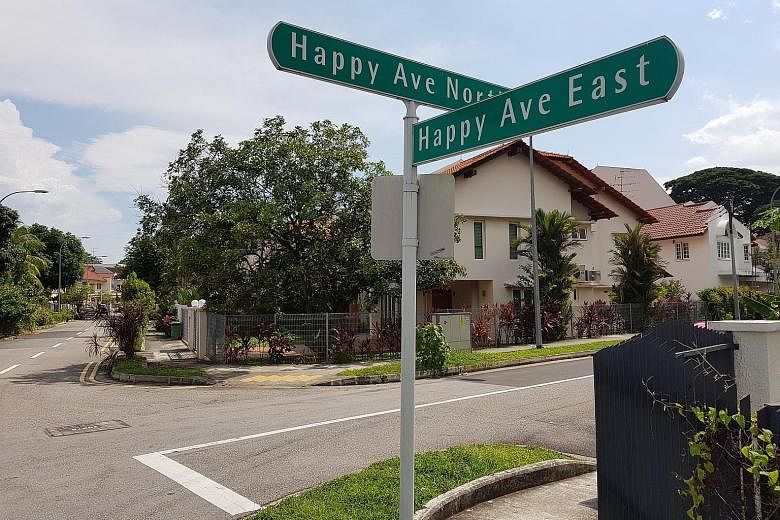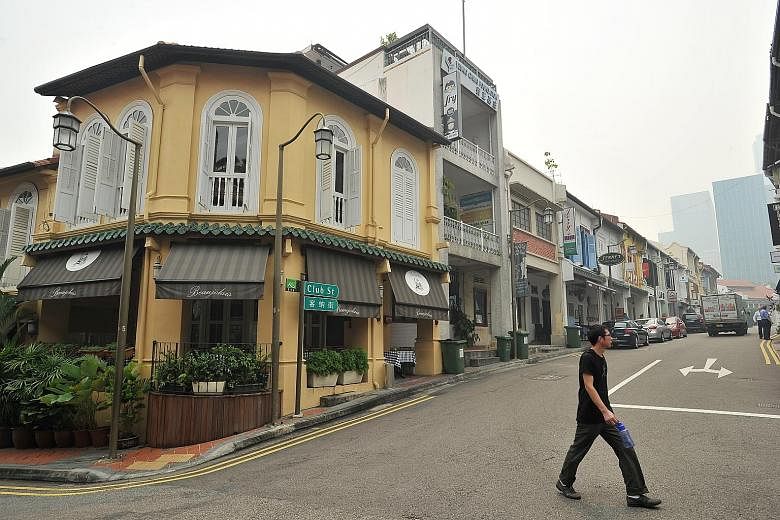Happy was the Maris Stella High School boy who, having counted the hours until the school bell rang, would rush to a secret hideout near his Housing Board flat in Circuit Road.
The neatly pruned avenues near a swampy riverbank - now the site of a drainage canal over a stretch of the Kallang-Paya Lebar Expressway - held precious childhood memories of hopscotch and marbles for Mr Stephen Chan.
This is Happy Avenue, an actual street name in MacPherson and not a moniker created by the now 55-year-old aircraft engineer.
"This is a peaceful place, where neighbours treat each other well and live harmoniously," said Mr Chan, who moved into a corner terraced house in the neighbourhood 14 years ago when one became available. "I had so many happy memories of this place, I sprang at the chance immediately."
Today, the street signs of Happy Avenue have become something of a minor attraction, with tourists from nearby hotels visiting the neighbourhood to take pictures.
Some stay a while longer to wander through the four streets of Happy Avenue Central, North, West and East.
The estate was surrounded by light industries in neighbouring Jalan Anggerek in the past.
The 180 units in the neighbourhood stand on freehold land and are mostly occupied by elderly residents, some of whom have lived there since the estate's first houses were completed in the 1960s.
At around 5am, one can also find qigong practitioners in the adjacent Aljunied Park. This is also where the neighbourhood holds its community events and dinners, organised by the Happy Gardens Neighbourhood Committee (NC) .
Said retiree Ng Thian Ser, 68, a Happy Avenue resident of 56 years: "I don't mind the tourists. They come because we have a good name. People would always say, 'You mean there is such a place in Singapore?' "
Current NC chairman Sim Chee Kwong, 65, said: "The name connotes a positive energy and a good feeling, so I'm one of those who believe there is an effect on people."
Informal "kopi" sessions at a nearby coffee shop are often well attended, and serve as an opportunity for the community to voice issues they encounter.
But like every other private estate, it is not free from problems.
Happy Avenue also had its share of tragedies. A 2004 fire in one house killed a 63-year-old man, a Filipino maid was murdered in 2005 in a burglary that had gone wrong, and most recently in 2013, a dog owner was fined for starving his emaciated dog and refusing to take it to a vet for treatment.
"People here move on and those with conflicts work them out eventually," said resident and director of a workplace safety consultancy Seah Liang Bing, 60.
Could street names affect the mood of its residents?
One toponymics researcher, Mr Ng Yew Peng, believes there could be a link. "Emotions (in street names) may have an effect on its denizens, provided the environment is complementary to the name," said Mr Ng, 71, the author of the book, What's In The Name? How The Streets And Villages In Singapore Got Their Names.
The book is available at major bookstores, including Kinokuniya, Popular, MPH and Times, and chronicles thousands of place names since 1936, based on newspaper articles dating back to 1830, municipal records and Malay dictionaries.
The main objective of naming streets and buildings is to ensure that properties can be located quickly and efficiently by emergency and delivery services, taxi drivers and the public, the Street and Building Names Board told The Straits Times previously.
But they can have an etymological purpose too. As street names do not tend to change, they serve as a snapshot of a moment in history and can contain much anecdotal information of the time, said Mr Ng, the researcher.
Club Street, for example, was so named as there was a Hokkien businessmen's club - the Chwee Lan Teng Chinese Club - that owned 2ha of land in that area in the mid-1800s.
The club closed in 1884, and its land sub-divided and sold in smaller lots, with the clubhouse becoming the Weekly Entertainment Club in 1891, he added.
Jalan Langgar Bedok is one example of how an innocuous name has an unexpected effect, said Mr Ng.
"Langgar" means "knocking up against" in Malay, while Bedok was previously known as Bedoh, or "drum". Langgar Bedok thus stood for "beating the drum", an instrument which was used to drive away wild animals or call villagers to prayer.
"However, most people associate langgar with car accidents. I know someone who had difficulty in selling his property along this road because potential buyers did not like to live on 'Accident Road'," he said.



